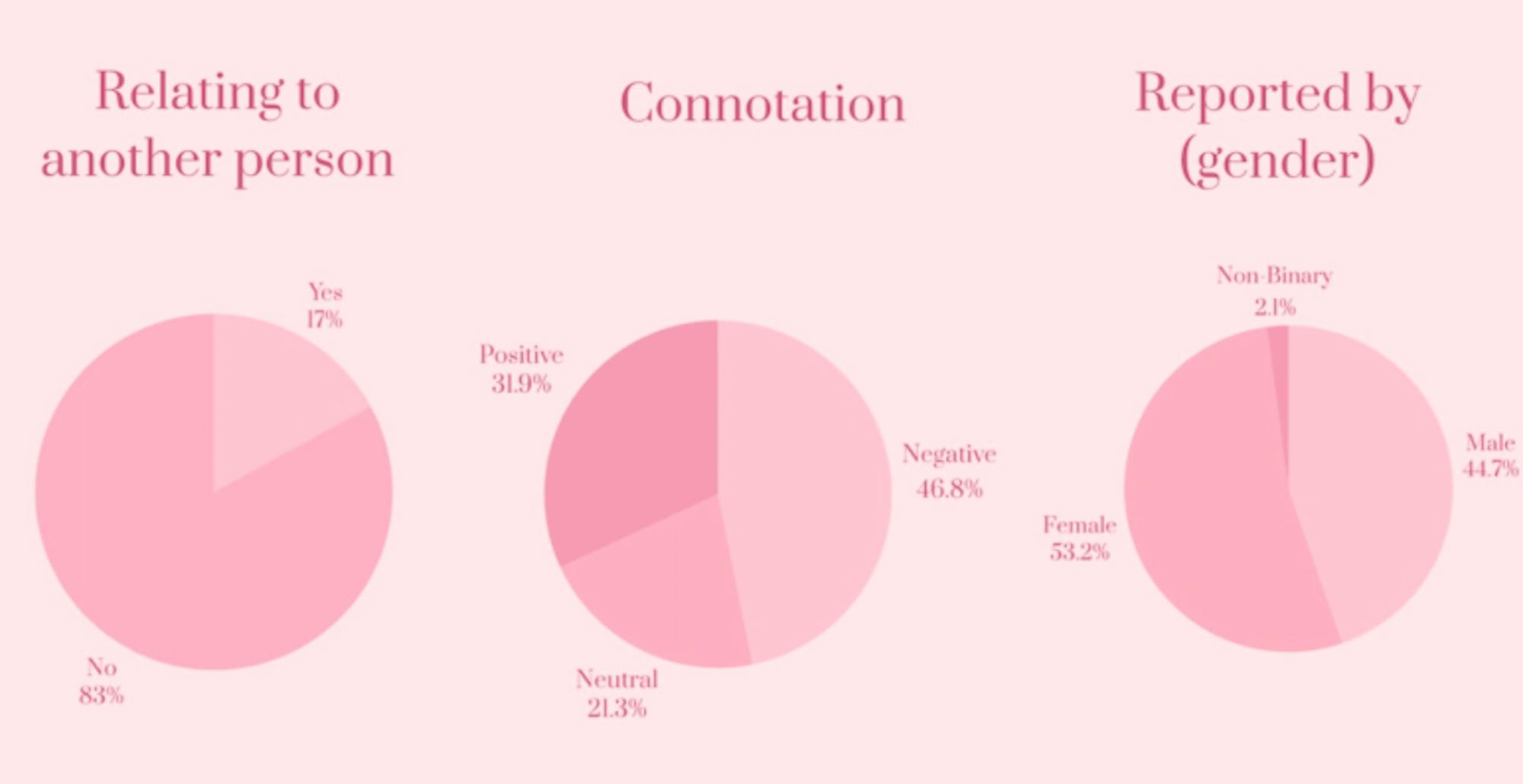For the past 300 years, Valentine’s Day has been renowned as a day of love, lust, gratitude, pink hearts, chocolate and dinner dates. While many consider the Day of Love one of the happier modern holidays, others find themselves feeling overwhelmed or lonely. All things considered, it’s time we pay long-deserved homage to the range of feelings brought about on Feb. 14th.
To gain a better understanding of how diverse feelings about Valentine’s Day are, I conducted a survey via my Instagram to see what vocab words come to mind when my followers (column readers) think about Valentine’s Day. 24 hours and 50ish responses later, here’s what I was left with:
Right away, you’ll see some noteworthy submissions, everything from “massacre” to “sex.” Here are some simple summary statistics breaking down responses:

The analysis that particularly resonates with me shows the distribution of connotations of each response (“Positive” being words like adorable and gratitude, “Negative” being words like overrated and vomit, and “Neutral” being words like “pink” and “scallops”). You’ll notice that nearly half the total responses to the prompt “What word comes to mind when you think of Valentine's Day?” were negative and, considering the neutral ones, only 32 percent of respondents associated Valentine’s Day with a positively connotated word. The top reported word was lonely and not one single person submitted the word love.
So, according to readers, it seems Valentine’s Day has become associated with loneliness instead of love. Why is this, and is it possible that Feb. 14th has always caused feelings of isolation to rear their head? Has society’s red and pink consumerist takeover (consumerism being the second-most reported word) tricked us into thinking we’re the only ones who feel alone on this February day, and should we feel guilty for feeling so? This is where the day’s history comes into play; its blurry origins help trace and validate the apparent modern-day love-to-lonesome pipeline.
Although the official namesake of Valentine’s Day is disputed, there were (at least) three different historical Catholic Saint Valentines, all of whom were put to death as martyrs in third-century Rome. One conducted secret marriages after Emperor Claudius II outlawed marriage (he realized that men performed much better in battle when they didn’t have wives to return home to, go figure). Another was allegedly put to death for aiding in Christian liberation from Roman prisons. This Valentine is said to have sent the first actual “valentine” to his jailer’s daughter — from his holding cell — before his execution.
Even though these Saints were killed in the third century, Valentine's Day wasn’t commercialized via greeting cards and flowers for nearly 1,500 years, and it took a couple hundred more years to make it to the United States. How did we decide on the 14th of February, you might ask? (Perhaps to commemorate the deaths or arrests of the Valentines?) Well, it was actually just a quick ploy to redirect attention from the pagan holiday, Lupercalia, which wasn’t sitting well with Christians at the time.
Today’s Valentine’s Day merchandise also commonly features the Greco-Roman god, Cupid. While admittedly a much more visually appealing advertisement than the more authentic option — beheaded Saints — Cupid is also a completely random attribution to the day.
Regardless of which Roman Saint Valentine we celebrate on February 14th, they had one thing in common: They were not celebrating “Valentine’s Day” with their loved ones. They were either dead or awaiting death in Roman holding cells, which actually sounds quite lonely to me.
Thus, Valentine’s Day is a flawlessly orchestrated cut-and-paste marketing scheme. Its red hearts, overpriced roses and lofty expectations weren’t normalized until over a thousand years after the death of the Saint(s) it claims to celebrate. The date chosen for its celebration was simply to override a less accepted holiday, and its No. 1 market image, Cupid, has absolutely nothing to do with the namesake Saints or the historic February 14th. We put pressure on a holiday so made-up we don’t even get a day off of work.
So, if your feelings on February 14th are ones of joy and gratitude for a day spent with loved ones (partners and friends alike), be thankful that you have that opportunity and aren't instead being held in a Roman prison. And if your feelings are negative, don't kick yourself, there is no need to disguise them with cherubs and red roses. But I hope to reassure you that despite how it seems, Valentine's Day does not need to make you sad.
If you are feeling so, I urge you instead to reflect on the history and origins of the day being celebrated. Have a laugh at the hodgepodge of history and marketing meticulously melded together to create a day that elicits similar feelings for so many people (46.8 percent of my Instagram followers), and appreciate that the historical Saint Valentine would probably have negative associations with the day as well; it would seem that their histories aren’t too far in the rearview. Whatever you're feeling on this February 14th, feel it authentically. If for no other reason than out of spite of how hilariously inauthentic Valentine’s Day is.
Grace Elmore is a student at Cornell University. Comments can be sent to gelmore@cornellsun.com. Grace and her column can be found on Instagram, @graace.elmoree Let’s Talk About Sex runs during alternate Sex on Thursdays this semester.











